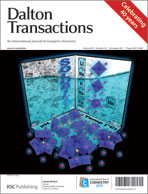Three novel 3,5-diamino-1,2,4-triazole (Hdatrz)-based CoII coordination complexes, [Co(Hdatrz)0.5(H2O)2(btec)0.5]n (1), {[Co(Hdatrz)(Hbtc)]·H2O}n (2) and [Co2(datrz)2(nb)2]n (3) (H4btec = 1,2,4,5-benzenetetracarboxylic acid, H3btc = 1,3,5-benzenetricarboxylic acid and Hnb = 4-nitrobenzoic acid), were synthesized by incorporating different carboxylate-containing co-ligands and then were structurally and magnetically characterized. Complex 1 is a 3D pillared-layer framework with corrugated CoII-btec4− layers supported by neutral μ2-N1, N4–Hdatrz ligands. In contrast, the other two complexes are chiral (4, 4)- and racemic (4, 82)-topological layers with asymmetric μ2-N1, N4–Hdatrz-bridged helical chains extended by bis-monodentate Hbtc2− ligands for 2 and with a μ3-N1, N2, N4-datrz− aggregated Shastry–Sutherland magnetic layer for 3. More interestingly, different magnetic phenomena with a field-induced metamagnetic transition from antiferromagnetic ordering to a ferromagnetic state for 1, spin-canted antiferromagnetism with a TN lower than 2.0 K for 2, as well as the coexistence of spin frustration and spin–flop transitions for 3 were observed, which, significantly, are governed by the local low-dimensional magnetic motifs mediated by the carboxylate and/or triazolate heterobridges in the anisotropic CoII–triazolate system.


 Please wait while we load your content...
Please wait while we load your content...